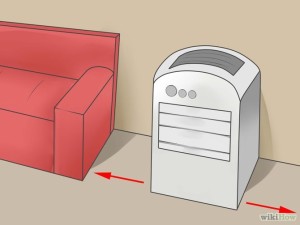
Image Courtesy of WikiHow.com
The ideal relative humidity (RH) level for a room is between 45% – 55% though this may drop down to 40% during the winter months to avoid condensation on windows etc.
If the RH stays at over 65% for a prolonged period of time mould is likely to grow therefore a dehumidifier can help keep the air moisture level down.
Preferably you should use a hygrometer to detect the correct RH level for each room in your home as each room will most likely have a different reading.
During the cooking of food the kitchen should have a higher reading than the living room. Similarly when having a shower the bathroom will show a higher humidity reading than say the dining room.
Real Estate Agent Sally Hahn agrees that hygrometers are important;
“A good first step is to invest in a hygrometer to determine, and then monitor, the humidity level throughout your home. Once you identify the areas that would benefit from reduced moisture you can then build your plan to manage your in-home humidity.”
If you don’t have a hygrometer (or don’t want to buy one even though they are not expensive) then you can gauge the relative humidity level as follows:
Humidity Level Over 65%
- Air feels ‘close’ or ‘stuffy’
- Skin feels moist & clammy
- It gets harder to breathe
- There could be a musty odor in room
Humidity Level Under 35%
- Skin becomes dry, flaky and/or itchy
- Lips become chapped and may crack & bleed
- Paint may start peeling of walls & furniture
- Wooden instruments and furniture may warp
The above humidity levels lie outside of our comfort levels so a dehumidifier should be used well before symptoms of very high humidity levels occur.
Take The Ice Test
In order to check if the air is too dry you can take the ‘Ice Test’.
Simply fill a glass with water and place three ice cubes into the water. Stir and leave to stand for 3 minutes. If no water droplets have formed on the outside of the glass after this time then the air is too dry.
[wp_ad_camp_1]
How To Use A Dehumidifier 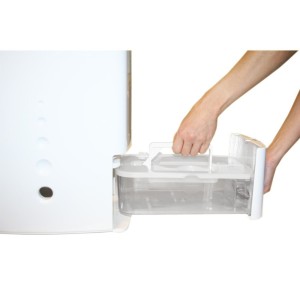
Two Types of Dehumidifier
First of all there are two main types of full size dehumidifier.
They are:
- Compressor dehumidifiers
- Desiccant Dehumidifiers
Very basically a rough usage guide would be to use a compressor dehumidifier if the dehumidifier will be mostly used in temperatures above 20°C (such as a very warm house or during the summer).
You should use a desiccant dehumidifier if the dehumidifier will be used mostly in temperatures of below 20°C (if using the dehumidifier in areas of the house where the heating is turned off in winter for example).
Compressor dehumidifiers become more efficient in extraction as the temperature rises.
Desiccant dehumidifiers are more stable in efficiency than compressor units but become slightly more efficient as the temperature falls. Desiccant units can also operate at lower temperatures than compressor units which is worth bearing in mind if you are looking for a garage or shed dehumidifier.
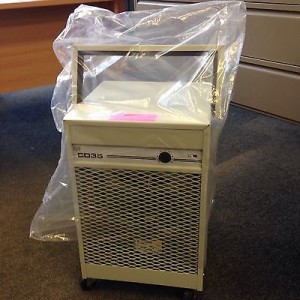
Image Courtesy of Ebay.com
Unpacking Your Dehumidifier
The reason the two types of dehumidifier were explained above is that each type of dehumidifier should be handled differently after you have unpacked your dehumidifier.
Obviously the first thing after unpacking your unit is to check that all the parts, such as a hose for continuous drainage, are included. If there are parts missing then you should ring the seller immediately.
Also don’t forget to fill out the warranty cards and send them away. At ByeMould we recommend taking out an extended warranty term if applicable as dehumidifiers are electric appliances and we feel that it is better to be safe than sorry.
Stand a Compressor Dehumidifier Before Use
Upon unpacking a compressor dehumidifier you should leave the unit to stand without operating it for at least an hour.
Different dehumidifier manuals give different time lengths to stand a dehumidifier
During transportation the oil in the compressor may have leaked into the system. If you let the dehumidifier (or fridge etc) stand the oil will settle back allowing the dehumidifier to function properly.
If the dehumidifier is used too soon then the system could get blocked which results in a system breakdown. It is likely that your warranty won’t provide cover if this happens.
Using a Desiccant Dehumidifier For The First Time
Unlike compressor dehumidifiers desiccant models lack a compressor component.
The lack of compressor makes desiccant dehumidifiers generally lighter and quieter than compressor models.
Also due to lack of compressor parts desiccant dehumidifiers can be used as soon as they are unpacked.
Smell From Desiccant Dehumidifier
When using a desiccant dehumidifier for the first time, and for a few times after, you may notice a slight burning smell coming from the dehumidifier.
This smell is perfectly normal as the Zeolite desiccant material absorbs smells from items such as cigarettes, hair sprays and cosmetics etc. When the desiccant material is heated these smells are then discharged back into the room.
The smell won’t last long and is not a cause for concern.
Position of Dehumidifier
A common question is where to position a dehumidifier.
First of all ensure that the dehumidifier is placed on a solid, level flooring in an upright position.
Keep the dehumidifier away from walls, furniture and other objects that may impede airflow. Do not place any clothes etc on top of the dehumidifier.
Placing the Dehumidifier in a Room
When placing the dehumidifier in a room ensure that the appliance is placed on the floor. Placing the dehumidifier on top of tables or lockers can increase the chance of accidents.
Place the unit near a socket so that it can be plugged in without the aid of an extension lead.
Personally I’ve had the best result with placing the dehumidifier near the windows as a quick blast with the unit in Laundry Mode clears heavy condensation on the windows in around 5 – 10 minutes.
Placement is an individual decision as different problems require different solutions. For example you may have a damp wall which you may want to place the dehumidifier next to or you may want to clear the windows of condensation as mentioned above.
For single room use we strongly recommend this mini dehumidifier.
Placing the Dehumidifier in a Hall
The best place for a full size dehumidifier is in the hall or on a landing.
Ensure that all the doors leading to different rooms are open so that all the air in the house will migrate to the dehumidifier naturally.
Again keep the unit, and especially the air filter, free of any obstructions.
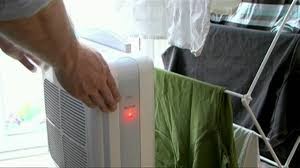
Image Courtesy of YouTube.com
Using a Dehumidifier to Dry Laundry
When using a dehumidifier to dry laundry you should use the smallest room in the house.
Hang the clothes on a clothes horse or similar contraption but do not place any clothes on top of the dehumidifier. Keep the clothes away from the dehumidifier so that if they do fall down from the clothes horse that they won’t fall on top of the dehumidifier.
Keep the doors and windows closed and run the dehumidifier in Laundry Mode for several hours.
You will find that when dehumidifiers operate in Laundry Mode they generate a lot of heat which helps dry clothes quicker.
The Meaco DD8L for example can heat the surrounding air temperature by up to 12°C!
First Time Using Your Dehumidifier
The first time that you use your dehumidifier the humidity level will be very high.
Close all the windows and external doors then place your dehumidifier in its most powerful setting and run the dehumidifier continuously.
Monitor the humidity level with either a hygrometer or via the LED screen on your dehumidifiers control panel.
If you have a manual dehumidifier then as the humidity level falls you can switch the dehumidifier into a lower setting.
If you have an automatic dehumidifier with energy-saving features such as E7 technology (in the case of EcoAir dehumidifiers) and Control Logic (Meaco Dehumidifiers) you can just set the dehumidifier in its highest setting and leave the unit to toggle into the most efficient setting as the humidity level falls.
You can read more about this process in this post: ‘How Long Should You Run a Dehumidifier’.
Dehumidifier Size
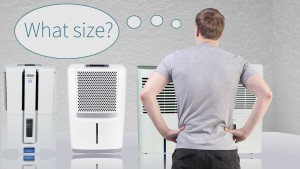
Image courtesy of YouTube.com
Ensure that your dehumidifier is the correct size for the area.
Using a dehumidifier that is too small for the area results in an inadequate removal of moisture meaning that mould, condensation or other damp may not be removed satisfactorily.
If a dehumidifier is too large for an area then extra energy will be used resulting in larger utility bills.
As a loose rule of thumb we recommend the following dehumidifiers:
- 1 room or small flat/apartment = EcoAir DD122 Mini
- 2 / 3 rooms or smaller house = EcoAir DD122FW Simple
- 4 rooms or larger house = Meaco DD8L
However if there are people suffering from airborne allergies in the house then we would recommend the EcoAir DD122MK5 as this unit contains both an anti-allergy Silver Nano filter and ioniser. Both of these features should make breathing easier for the affected person.
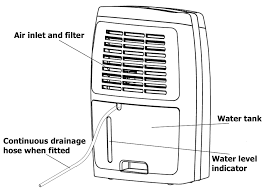
Image Courtesy of Meaco.com
Water Drainage
As mentioned above when using the dehumidifier for the first time you should run the unit on maximum power as the air will be very wet.
As such water extraction will also be at maximum levels and you may find that your water tank fills up quickly. For safety reasons and to avoid spillage every dehumidfier will turn off automatically when the water tank is full.
In order to keep the dehumidifier in constant operation it would be handy to empty the water tank before the tank gets full and the dehumidifier is switched off for an unknown length of time.
To empty the tank before the dehumidifier stops operating automatically turn the unit of on the control panel and wait 5 minutes before removing the water tank to ensure that all the water has dripped down into the tank.
Continuous Drainage
If your dehumidifier comes with a continuous drainage function which you would like to avail of then attach the hose as per instructions in the instruction manual.
Run the hose down in case of gravity-led systems or up in case of a motorised system. Ensure that the hose runs straight and is not kinked in any way.
If water refuses to flow through the hose and the system has been setup properly then insert a small hole in the top of the hose about 30cm away from the dehumidifier as this will allow air to help force the water down.
Dehumidifier Maintenance
Domestic dehumidifiers only need basic maintenance which can be performed by anyone.
Filters
First of all ensure that the filter is cleaned frequently. Cleaning the filter every two weeks or so keeps the airway clean and allows the dehumidifier to operate normally.
As you can imagine when the filter is dirty (and this will happen rapidly) the dehumidifier will have to work harder to pull air through the filter. As such the dehumidifier will deteriorate in quality much faster.
Standard dust filters can be washed or hoovered clean.
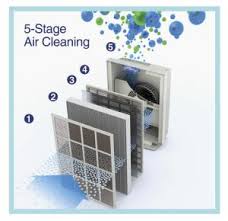
Image courtesy of Allbrands.com
Anti-Bacterial Filters
Due to their special germicidal coating anti-bacterial filters should never be washed as water will wash the coating away.
The only way these types of filters should be cleaned is by hoovering them.
Filters should always be cleaned before storing the dehumidifier away.
Power Lead and Continuous Drainage Hose
Ensure that the power lead and continuous drainage hose are not worn and don’t have any holes in them. Also ensure that they aren’t kinked. Replace if they are.
Water Tank
There should be no cracks in the water tank.
If you are planning to store the dehumidifier away, or if you are not using it for a while, then dry the water tank with a cloth.
Keep Coils Clean
For optimum performance the coils on a compressor dehmuidifier should also be kept clean.
As Jerry Alonzy, from TheNaturalHandyman.com explains;
‘The purpose of this cleaning is two-fold. First, dust and dirt can insulate the coils from the room air, decreasing the efficiency of the dehumidifier. Secondly, this same dirt will get damp and possibly freeze. Freezing is the most damaging thing that can happen to your dehumidifier because it will run continuously but not dehumidify the air. This will lessen the life of the unit and lighten your purse when the unit suffers a premature death! Not to mention the bill your smiling utility man will hand deliver with a “Thank You” note from the electric company.’

Image courtesy of Folpynsea.com
Read The Instruction Manual
Our final tip is for you to read your dehumidifier instruction manual carefully.
Warranty and guarantees only cover anything that happens to your dehumidifier outside of following the instructions in the manual.
So for example if your manual says that you should not put clothes on your dehumidifier then you should not do it. If your dehumidifier breaks down because of air expulsion difficulties then the warranty or guarantee may not be met.
Remember that a dehumidifier is like a fridge. It’s a large appliance and mechanical faults may occur. As such keep the details of the manufacturer in a safe place as generally large dehumidifier manufacturers and suppliers have good return policies.
In Conclusion
If you have read the above article thoroughly as well as your instruction manual you should have no problems operating your dehumidifier.
In case of compressor dehumidifiers remember to leave them stand for a minimum of an hour to let the oil settle.
In the case of desiccant dehumidifiers don’t be alarmed at the slight burning smell that you may encounter the first few times that you operate the dehumidifier.
Look after your dehumidifier, treat it with respect and it will reward you with many years of service.
If you are thinking of buying a dehumidifier or if you think that you have bought the wrong type of dehumidifier for your needs then check out these 21 awesome tips that explain exactly what to look for when buying a dehumidifier.
Did we leave something out in the above article? We aim to make our articles as thorough as possible in order to help you, the reader. If you think that we omitted some detail then please let us know in the comments below.

A fantastic guide to using a dehumidifier for your home, very useful!
I’m glad that you found the guide useful. 🙂
A good read looking to bring moisture levels down in my floors to lay timber flooring interesting read
Glad that you found the article useful Eimear.
In a small house, can it work in a central location? i.e. i have a central hall, with lounge, bedrooms and kitchen area off this. I was thinking of placing one here, with meters in each room, then leaving just the door of the room that needs lowering open, closing others. Would that draw moisture out? Would allow me to buy a bigger one with a fixed drain, rather than wheeling one around with a bucket.
Hi Jon, that would work as long as the house is small enough and the dehumidifier large enough. Get a few cheap damp meters, stick them in each room and see if the humidity comes down in all the room. If not reposition the dehumidifier until it does. An 8 litre desiccant or 16 litre compressor dehumidifier should do the trick if the house is small enough. I have found the Meaco Zambezi to be more powerful than other 8L desiccant models due to the larger condenser. Hope that helps a little.
Is it ok to dry laundry on a clothes horse using humidifier when not in the house?
There are only 2 places suitable to put a dehumidifier in my small home, and both have a radiator close by. Will that affect the efficiency?
You will find that some dehumidifiers can increase the room temperature by a large margin. The Meaco DD8L Compact for example can increase the room temperature by 10C. The most efficient way to use the dehumidifier is to turn the heating off and let the dehumidifier heat the room.
If using a dehumidifier with the heating on then maybe a compressor type dehumidifier would work best as they get more efficient the warmer the temperature. If using a dehumidifier with the heating off then a desiccant model might be better.
Hope that helps a little.
I think that you mean a dehumidifier instead of a humidifier. Dehumidifiers are electrical appliances so should not really be left on their own. However having said that I don’t know of any fires that have occurred in the UK or Ireland that were caused by dehumidifiers. Dehumidifier companies in the US have had huge problems but that’s because they cut costs and used cheap parts.
You’ll find that a timer will be your friend as a timer will ensure that the dehumidifier won’t overheat. I’ve run dehumidifiers unattended in my own house and rentals properties for hours on end without any problem.
Be sure to place the dehumidifier and clothes horse in the smallest room in the house (but not the hot press) and close all doors and windows for fastest drying.
Hope that helps.